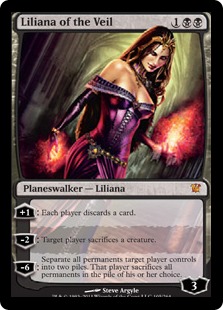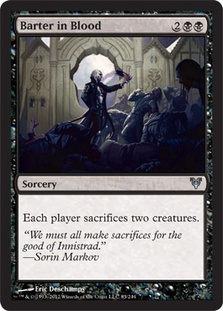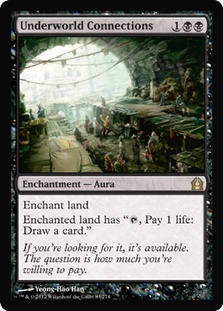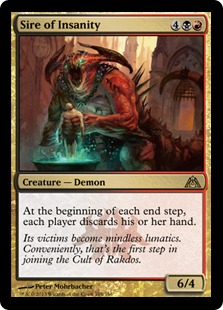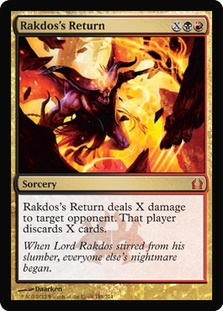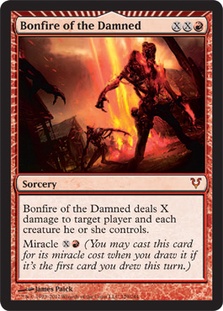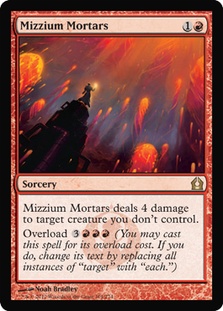"You told me to go back to the beginning…so I have." -Inigo Montoya
Hello.
My name is Mark Nestico.
Aggro decks that are ruining my format…prepare to die.
It’s no secret that I love Jund, and even though it has given me a lukewarm reciprocation in my affections as of late, it is still one of my favorite decks to play.
Recently, I made the switch to Naya, and while I still feel very strongly about Naya Midrange and how powerful it is, the surge in Junk Aristocrats has made me look back at my first girlfriend of the format, Jund.
She’s pretty, ain’t she?
One of the most common questions that viewers of my stream ask me is when I’m going to do a primer on Jund since for some reason I am considered an authority on it, albeit a loose one at best.
Well, I’m no Reid Duke. I don’t have the sexiest voice in all of Magic and a head full of beautiful hair. [Editor’s Note: And really, who does?]
I’m also no Owen Turtenwald, whose pioneering of the deck has shaped the way people have built it for the last month or so.
However, I’m lucky enough to be friends with a man who is a master of Jund in his own right. I figured if I was going to do a primer on one of my favorite decks of all time, the best person to start with would be my buddy Steve Mann. While his name doesn’t have the same notoriety as some other pro Magic players, Steve is a fixture on Magic Online and one of the top names in the online world. His handle, Randomdrooler, has earned him a ton of event Top 8s, packs, and victories.
Aside from regularly dominating Magic Online matches, he’s been on a bit of a tear lately on the Pro Tour circuit, with a 30th place finish at Pro Tour Return to Ravnica, 36th at Pro Tour Dragon’s Maze, and, most importantly, a Top 8 at Pro Tour Gatecrash with…you guessed it…Jund.
When looking for guidance on this popular archetype, Steve is one of the best players in the world to go to. Since this is for people who want to understand the ins and outs of Jund as well as players who might be looking for something different to sleeve up, I surmised that interviewing him would be the best way to go. It’s not very often you get this kind of insight, especially on a deck so powerful. Without further ado, I give you my interview with Steve Mann.
Mark: Thanks for sitting down with me, Steve! I guess the first question should be the most basic: why is Jund your personal deck of choice?
Steve: I feel like it gives me the most in-game options without playing a true control deck that doesn’t finish games fast enough.
It’s almost impossible to answer all the varied threats in today’s Standard, so it’s better to answer what you can and then close the door quickly.
Mark: I agree entirely. Jund offers a player the chance to play an aggressive role while maintaining a great deal of control over what their opponent does. The option of ending games quickly is very appealing since the majority of control decks aren’t able to put out a win condition until much later in the game. If much of that time is spent playing on the back foot, sometimes that can be too late.
Are you able to give us the decklist that you’re currently battling with?
Steve: Sure. Here’s where I’m at currently.
Creatures (12)
Planeswalkers (6)
Lands (25)
Spells (17)

Mark: Can you tell us about some of your card choices?
Steve: I made the switch to four Pillar of Flames because Voice of Resurgence is super popular at the moment as well as Strangleroot Geist.
I have four Liliana of the Veils because like I was saying earlier I’d rather not show up with a deck full of narrow removal spells. Liliana is a subpar removal spell that’s also my best friend against Hallowed Fountain decks.
Rakdos’s Return has been better for me than Sire of Insanity. Obviously, Sire is better in certain situations, but most the time it’s Return I want.
I’ve only gone back to Barter in Blood for a few days now, and it has impressed me every time I’ve cast it. Obviously, it’s very strong against Bant Hexproof, but it’s mostly there to straight up win the game on turn 4 against Mono-Red Aggro—it gets them every time.
I’m not playing Cavern of Souls, and as a result I’ve had a terrible time with U/W/X Control countering every relevant spell I play. Two Underworld Connections is my solution, as well as performing well against the mirror.
Mark: Talking about Sire of Insanity, he’s been noticeably absent from the well-performing decklists as of late. In St. Louis, he wasn’t even in the top two performing builds. Do you think the novelty has worn off, or is he just badly positioned at the moment?
Steve: I wouldn’t say it was novelty that had him seeing play; the 6/4 is oftentimes better than just a Mind Twist. I’ve had games where I’ve Rakdos’s Returned their hand away and ended up losing a drawn-out game where a 6/4 would have won it for me.
I think it’s more of the fact that everyone knows Sire exists and that they’re playing cards like Warleader’s Helix and Turn // Burn to deal with it. If you’re leaning on Sire to clean up, now you have to fight through burn spells as well as counterspells, whereas Rakdos’s Return only cares about the latter.
Mark: Given that you were able to make the Top 8 of Pro Tour Gatecrash with Jund a few months back, do you think Jund’s position in the metagame has become better or worse since then?
Steve: Well, since then plenty of new decks have been introduced to the metagame, so a midrange deck like Jund certainly has a harder time answering threats now than it did earlier this year.
At Pro Tour Gatecrash, we had a short list of decks we anticipated and built our 75 to beat all of them. These days I feel that’s impossible, and I basically have to choose which matchups I’m willing to lose to—there’s just no way to cover all the bases.
That being said, the other decks in the format aren’t having any easier time doing the same. Jund is notorious for its adaptability, so in a wide-open field such as this Jund is probably an even better deck choice now.
(This is the part of the interview that blew my mind.)
Mark: Being willing to understand there are some matchups that you have to cut your losses on and move forward from is an extremely disciplined philosophy.
How many times before an event have you tried to overload your sideboard with something for every single deck out there, only to come up short in other matchups that should have had more attention to begin with? Saying to yourself, "I’m probably going to see a lot more of Deck A as opposed to Deck B, so I should prepare for Deck A," can be a hard pill to swallow since players hate losing ground on any matchup. This kind of focus is what players refer to as Next Level thinking: worry about the majority, not the whole.
With that in mind, though, what are the decks you absolutely love to play against? In the same vein, what are the matchups you’d like to avoid?
Steve: Jund hates to see any deck that doesn’t attack to win. Of course, it’s not surprising that a red-black deck handles creatures well.
Sadly, Wizards has pushed the game in a direction that allows for a mono-removal deck such as Jund to prevail. As Standard players, we’re more-or-less forced to play a disgusting amount of maindeck creature removal or risk losing to 80-85% of the field.
As a result, when an opponent shows up with Aetherling and company, you have to beat them with half the spells in your deck game 1, which can prove quite difficult.
Mark: I’ve been dealing with the same problem online as well. It just feels like your concentration of good spells against decks like U/W/R is terribly weak game 1. Speaking of decks that people perceive to be a problem, what’s your take on all of The Aristocrats decks that have popped up? They seem to come in all flavors, with Act I, Act II, and now Junk Aristocrats. How do you feel about the Junk Aristocrats matchup?
Steve: I’ve been told that The Aristocrats players do not like to see Blood Crypt across the table…
I could not agree more.
I love seeing turn 1 Doomed Traveler.
Mark: Slick answer.
Since you don’t seem terribly afraid of The Aristocrats decks, what are your feelings about the mirror match? As Patrick Chapin pointed out, Jund is still 12-15% of the expected metagame. If you plan on going deep in a tournament, you’re probably going to have to play against the mirror, so what cards do you think carry the most weight in the matchup?
Steve: It’s a very tricky matchup, and I’ve admittedly not mastered it.
Drawing Farseek is more important in this matchup than any other, I will say that much.
Being the first to play Garruk, Primal Hunter is also a huge swing because if you manage to draw five with it, the game might just be over—likewise with Underworld Connections.
It’s important to not trade your Thragtusks off if you’re opening yourself up to a Bonfire of the Damned or Mizzium Mortars blowout, as well as to make sure you get on the board fast before a Sire of Insanity makes your life miserable.
Mark: I’ve dealt with the same conundrums. You have to have a solid read on your opponent a lot of the time in order to maximize your card advantage. In a world full of Deadbridge Chants and Bonfire of the Damneds, your card quality has to be so much better in the mirror than theirs. I can’t begin to tell you how many times opponents have opened themselves up to making my non-miracled Bonfires a million times better by wantonly throwing their cards onto the board and trying to make them stick.
I’ve found the best avenue to victory is to be smart with your removal and make sure you have at least one card engine in your opening hand, like Underworld Connections; Deadbridge Chant; or Garruk, Primal Hunter.
For a person who is just picking up Jund or thinking of switching to it, what are some helpful tips or tricks you’d give them?
Steve: Hard to figure out how to answer that one (laughs).
- Well, there’s the obvious don’t play your Huntmaster of the Fells if they have one in play because of the way the flip triggers work. If you have a Huntmaster and they nonchalantly play theirs, you know they have instant speed removal, so don’t just ship turn without playing a spell.
- If you’re playing against a Naya or Bant deck, consider playing Liliana of the Veil and not activating it to maximize your cards. Chances are the sacrifice ability will be safe for when they play something with hexproof that your targeted removal can’t kill.
- Don’t side in Barter in Blood against just anything. It must be a creature rush deck.
- It’s better to kill things with Olivia Voldaren than to steal them.
- Your best weapon against Aetherling is a turn 3 Liliana of the Veil. If you fear a counterspell, it doesn’t matter. A turn 4 Liliana is not good enough.
(I emphasized that last part because I feel it is the most profound.)
Mark: Winding things down, is there anything you’d like to see in M14 for Jund?
Steve: Cultivate or something in the three spot like Sprouting Thrinax would be excellent since there’s such a huge gap in the two-to-four-drop spot.
Mark: We can dream, Steve. Last question: is Jund what you’re eyeing for Grand Prix Miami?
Steve: Most likely yes.
I do all of my testing online, so I’d like to get some physical games in to see if there’s anything I’ve missed, but so far Jund looks promising.
Mark: That’s awesome to know. Is there anything else you’d like to leave the readers with?
Steve: I have a confidence issue, so don’t assume this is a perfect decklist (laughs).
Mark: Thanks, Steve!
…
…
…
Well, there you have it! You’ve just been inside the mind of a Jund master. How does it feel? Do you feel dizzy?
Going forward, Jund is a deck that I not only love but also am seriously considering for the next few big events I’m playing in. While it hasn’t always been the breadwinner that I’m used to it being for me, I can say that the reliability and sheer power are what keep me coming back to it.
Do yourself a favor and test with this beast. Just don’t let me find out that she’s been cheating on me.
Enjoy your Junding, kids.
Catch ya on the flip-
Mark

